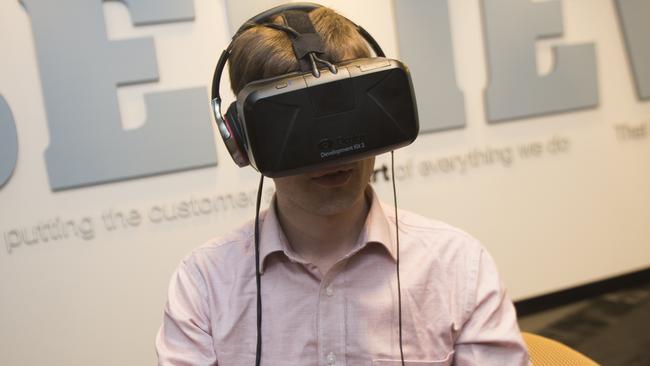Mark Zuckerberg’s $2 billion virtual reality vision for Facebook
IN THE not too distant future, virtual reality videos will fill a user’s Facebook feed as often as a photo or a status update. Yes, that’s right. Virtual reality.

MARK Zuckerberg has a vision. A $2 billion, virtual reality vision.
In the not too distant future, virtual reality videos will fill a user’s Facebook feed as often as a photo or a status update.
Yes, that’s right. Virtual reality.
Gone will be the two-dimensional images we see today, instead, they’ll be replaced with a whole new world where “you feel like you’re standing on top of the Eiffel Tower, even though you’re in a room”, said Facebook’s head of Open Source, James Pearce.
In early 2014, Facebook bought virtual reality technology company Oculus for $2 billion in cash and shares.
At the time, Zuckerberg said mobile was the platform of the day, “and now we’re also getting ready for the platforms of tomorrow. Oculus has the chance to create the most social platform ever, and change the way we work, play and communicate”.
He described Oculus as the leader in immersive virtual reality technology with a strong following among developers.
But now, as soon as next year, the technology will also be available to consumers.
“It’s mind blowing because you forget you’re sitting in a chair or standing in a room, you start to think you’re on a beach or in space, it’s really magical,” Mr Pearce told news.com.au at tech conference Scale, in San Jose, California.
“This virtual reality medium is a new opportunity. That’s something we’re going to be launching as a consumer product next year. It’s really exciting.
“One of Mark’s visions in this respect is that that’s the sort of thing people will share on Facebook.
“You’ll go to your Facebook news feed and you’ll see virtual reality stories in there in the same way you see videos and photos today, and if you’ve got the right device on at the time you’ll be able to step into the world your friend was in when they took that image.”
That “device” is the Oculus Rift headset, which uses stereoscopic vision and tracking dots to give the impression of looking around another world.
The headset was praised for its ability to bring gamers into the picture like never before.
“It shows different things on the screen, if you look up it shows the ceiling if you look down it shows the floor, and the computer is able to calculate them in real time. As you move around you literally feel like you’re there,” said Pearce.
“You can just imagine sitting in San Francisco and your friends on holiday in Italy and they’ve taken on of these 360 videos and then you’re transported there immediately.
“Ultimately you might say, ‘well why is Facebook working on something like virtual reality, it seems absurd and unrelated to what we do’, but it’s exactly related to what we do because it’s this beautiful way of sharing not just an image but a whole experience from some other location, time or place.
“You can just imagine grandparents able to be in the room with their grandchildren, even if they’re on the other side of the world, and interact with them through these kinds of devices.”
The virtual reality video will only be available on desktop to begin with, but, as Pearce said, “Facebook’s mission is to make the world connected through whatever technology is available, in the future who knows whatever trends will make it easier to connect with friends and family?”
Facebook is also reportedly working on a separate mobile app that will allow users to tilt their phones to view the videos from different angles, the Wall Street Journal reports.
A launch date for both products is yet to be set.



